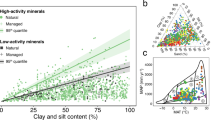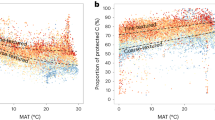Abstract
A large source of uncertainty in present understanding of the global carbon cycle is the distribution and dynamics of the soil organic carbon reservoir. Most of the organic carbon in soils is degraded to inorganic forms slowly, on timescales from centuries to millennia1. Soil minerals are known to play a stabilizing role, but how spatial and temporal variation in soil mineralogy controls the quantity and turnover of long-residence-time organic carbon is not well known2. Here we use radiocarbon analyses to explore interactions between soil mineralogy and soil organic carbon along two natural gradients—of soil-age and of climate—in volcanic soil environments. During the first ∼150,000 years of soil development, the volcanic parent material weathered to metastable, non-crystalline minerals. Thereafter, the amount of non-crystalline minerals declined, and more stable crystalline minerals accumulated. Soil organic carbon content followed a similar trend, accumulating to a maximum after 150,000 years, and then decreasing by 50% over the next four million years. A positive relationship between non-crystalline minerals and organic carbon was also observed in soils through the climate gradient, indicating that the accumulation and subsequent loss of organic matter were largely driven by changes in the millennial scale cycling of mineral-stabilized carbon, rather than by changes in the amount of fast-cycling organic matter or in net primary productivity. Soil mineralogy is therefore important in determining the quantity of organic carbon stored in soil, its turnover time, and atmosphere–ecosystem carbon fluxes during long-term soil development; this conclusion should be generalizable at least to other humid environments.
This is a preview of subscription content, access via your institution
Access options
Subscribe to this journal
Receive 51 print issues and online access
$199.00 per year
only $3.90 per issue
Buy this article
- Purchase on Springer Link
- Instant access to full article PDF
Prices may be subject to local taxes which are calculated during checkout



Similar content being viewed by others
References
Schimel, D. S. et al. Climatic, edaphic, and biotic controls over storage and turnover of carbon in soils. Glob. Biogeochem. Cycles 8, 279–294 (1994).
Oades, J. M. The retention of organic matter in soils. Biogeochemistry 5, 35–70 (1994).
Vitousek, P. M., Turner, D. R. & Kitayama, K. Foliar nutrients during long soil development in Hawaiian montane rain forest. Ecology 76, 712–720 (1995).
Crews, T. E. et al. Changes in soil phosphorus fractions and ecosystem dynamics across a long chronosequence in Hawaii. Ecology 76, 1407–1424 (1995).
Goh, K. M., Rafter, T. A., Stout, J. D. & Walker, T. W. The accumulation of soil organic matter and its carbon isotope content in a chronosequence of soils developed on aeolian sand in New Zealand. J. Soil Sci. 27, 89–100 (1976).
Scharpenseel, H. W. & Becker-Heidmann, P. Twenty-five years of radiocarbon dating soils: paradigm of erring and learning. Radiocarbon 34, 541–549 (1992).
Wang, Y., Amundson, R. & Trumbore, S. Amodel for soil 14CO2and its implications for using 14C to date pedogenic carbonate. Geochim. Cosmochim. Acta 58, 393–399 (1994).
Herbert, D. Primary productivity and resource use in Metrosideros polymorpha forest as influenced by nutrient availability and hurricane Iniki. Thesis, Univ. Hawaii, Manoa(1995).
Jackman, R. H. Accumulation of organic matter in some New Zealand soils under permanent pasture. II. Rates of mineralization of organic matter and the supply of available nutrients. NZ J. Agric. Res. 7, 472–479 (1964).
Wada, K. in Minerals in Soil Environments (eds Dixon, J. B. & Weed, S. B.) 283–304 (Soil Sci. Soc. Am., Madison, 1986).
Martin, J. P. & Haider, K. in Interactions of Soil Minerals with Natural Organics and Microbes (eds Huang, P. M. & Schnitzer, M.) 283–304 (Soil Sci. Soc. Am., Madison, 1986).
Schwertmann, U. & Taylor, R. M. in Minerals in Soil Environments (eds Dixon, J. B. & Weed, S. B.) 379–438 (Soil Sci. Soc. Am., Madison, 1989).
Allen, B. L. & Hajek, B. F. in Minerals in Soil Environments (eds Dixon, J. B. & Weed, S. B.) 199–278 (Soil Sci. Soc. Am., Madison, 1989).
Post, W. M. in The Global Carbon Cycle (ed. Heimann, M.) 277–302 (Springer, Berlin, 1983).
Kononova, M. M. in Soil Components Vol. 1, Organic Components (ed. Gieseking, J. S.) 475–520 (Springer, New York, 1975).
Schlesinger, W. H. Evidence from chronosequence studies for a low carbon-storage potential of soils. Nature 348, 232–234 (1990).
Harden, J. W., Sundquist, E. T., Stallard, R. F. & Mark, R. K. Dynamics of soil carbon during deglaciation of the Laurentide ice sheet. Science 258, 1921–1924 (1992).
Saggar, S., Tate, K. R., Feltham, C. W., Childs, C. W. & Parshotam, A. Carbon turnover in a range of allophanic soils amended with 14C-labelled glucose. Soil Biol. Biochem. 26, 1263–1271 (1994).
Jenkinson, D. S. & Raynor, J. H. The turnover of soil organic matter in some of the Rothemsted classical experiments. Soil Sci. 123, 298–305 (1977).
Parton, W. J., Schimel, D. S., Cole, C. V. & Ojima, D. S. Analysis of factors controlling soil organic matter levels in Great Plains grasslands. Soil Sci. Soc. Am. J. 51, 1173–1179 (1987).
Townsend, A. R., Vitousek, P. M. & Trumbore, S. E. Soil organic matter dynamics along gradients in temperature and land-use. Ecology 76, 721–733 (1995).
Trumbore, S. E., Chadwick, O. A. & Amundson, R. Rapid exchange between soil carbon and atmospheric carbon dioxide driven by temperature change. Science 272, 393–396 (1996).
Eswaren, H., Berg, E. V. D. & Reich, P. Organic carbon in soils of the world. Soil Sci. Soc. Am. J. 57, 192–194 (1993).
Post, W. M., Emanuel, W. R., Zinke, P. J. & Stangenberger, A. G. Soil carbon pools and world life zones. Nature 298, 156–159 (1982).
Jenny, H. Factors of Soil Formation (McGraw-Hill, New York, 1941).
Hudson, B. D. The soil survey as paradigm-based science. Soil Sci. Soc. Am. J. 56, 836–841 (1992).
Vogel, J. S. Arapid method for preparation of biomedical targets for AMS. Radiocarbon 34, 344–350 (1992).
Stuiver, M. & Polach, H. Reporting of 14C data. Radiocarbon 19, 355–363 (1977).
Jackson, M. L., Lim, C. H. & Zelazny, L. W. in Methods of Soil Analysis. Part 1; Physical and Mineralogical Properties (ed. Klute, A.) 102–149 (Am. Soc. Agronomy: Soil Sci. Soc. Am. Madison, 1986).
Parfitt, R. L. & Henmi, T. Comparison of an oxalate extraction method and an infrared spectroscopic method for determining allophane in soil clays. Soil Sci. Plant Nutr. 28, 183–190 (1982).
McKeague, J. A. & Day, J. H. Dithionite- and oxalate-extractable Fe and Al as aids in differentiating various classes of soils. Can. J. Soil Sci. 46, 13–22 (1966).
Acknowledgements
We thank S. Zheng and T. Crews for technical assistance; Lawrence Livermore National Laboratory's Center for Accelerator Mass Spectrometry for radiocarbon analysis; The Nature Conservancy, US National Park Service, Parker Ranch, Kahua Ranch, Hawaii Division of Forestry and Wildlife, Hawaii Division of State Parks, and the Joseph Souza Center for access to field sites; and E.Davidson, J. Gaudinski and J. Harden for comments on the manuscript. This work was supported by National Science Foundation, Mellon Foundation, Joan Irvine Trust, and Jet Propulsion Lab-California Institute of Technology on contract to NASA.
Author information
Authors and Affiliations
Corresponding author
Rights and permissions
About this article
Cite this article
Torn, M., Trumbore, S., Chadwick, O. et al. Mineral control of soil organic carbon storage and turnover. Nature 389, 170–173 (1997). https://doi.org/10.1038/38260
Received:
Accepted:
Issue Date:
DOI: https://doi.org/10.1038/38260
This article is cited by
-
Geomorphic controls on the abundance and persistence of soil organic carbon pools in erosional landscapes
Nature Geoscience (2024)
-
Spatial patterns of historical crop yields reveal soil health attributes in US Midwest fields
Scientific Reports (2024)
-
Soil acidity accelerates soil organic matter decomposition in Cryptomeria japonica stands and Chamaecyparis obtusa stands
Plant and Soil (2024)
-
Stabilization mechanisms of organic matter in Andosols under long-term fertilization as revealed from structural, molecular, and stable isotopic signatures
Journal of Soils and Sediments (2024)
-
Soil carbon storage capacity of drylands under altered fire regimes
Nature Climate Change (2023)
Comments
By submitting a comment you agree to abide by our Terms and Community Guidelines. If you find something abusive or that does not comply with our terms or guidelines please flag it as inappropriate.



